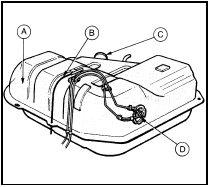Fuel tank - removal and refitting
Note: Refer to the warning at the end of Section 1 before proceeding.
Removal
1 The fuel tank will normally only need to be
removed if it is severely contaminated with
sediment or other substance, or requires
repair.
2 As there is no drain plug incorporated in the tank, the best time to remove it is when it is nearly empty. If this is not possible, syphon as much fuel as possible from the tank into a container which can be sealed, but before doing so, observe the following precautions: a) Disconnect the battery, negative lead first.
b) Do not smoke or bring naked lights near.
c) Avoid placing the vehicle over an inspection pit as the fuel vapour is heavier than air.
3 With the rear of the vehicle raised and supported securely, disconnect the flexible hose connection between the sections of rigid fuel line at the front face of the tank (see illustration). On some models dual pipelines are used, the second one being a fuel return line which returns excess fuel from the carburettor.

6.3 Fuel tank flexible hose connections at front of tank
4 Disconnect the electrical leads from the tank sender unit.
5 Brush away all adhering dirt and disconnect the tank filler pipe and vent pipes from the tank pipe stubs (see illustration).

6.5 Fuel tank filler and vent pipe locations (arrowed)
Additionally, on 1986 models onwards, disconnect the filler vent pipe.
6 Support the tank and unscrew the bolts from the support straps (see illustration).

6.6 Fuel tank support strap bolt (arrowed)
7 Lower the tank until the fuel hoses can be detached from the sender unit and from their retaining clips. On 1986 models onwards disconnect the small bore vent pipe located on the top face of the tank (see illustration).

6.7 Fuel tank assembly
A Fuel tank
B Vent pipe
C Fuel filler stub
D Fuel gauge sender unit
Lower the tank fully and remove it from under the car.
Refitting
8 If the tank is to be cleaned out, repaired or
renewed, remove the sender unit. To do this,
unscrew the unit in an anti-clockwise direction
using the special tool (23-014) or a suitable
lever engaged behind the tabs.
9 If the tank contains sediment or water, clean it out by shaking vigorously using paraffin as a solvent. After several changes, rinse out finally with petrol.
10 If the tank is leaking, leave repair to a specialist company. Attempting to weld or solder the tank without it first having been steamed out for several hours is extremely dangerous.
11 Refit the sender unit using a new sealing ring.
12 Refit the tank into the vehicle by reversing the removal operations. Check all connections for leaks after the tank has been partly filled with fuel.
See also:
Engine dismantling, examination, renovation and reassembly - general
information
Dismantling
1 It is best to mount the engine on a
dismantling stand but if this is not available,
stand the engine on a strong bench at a
comfortable working height. Failing this, it will
have to ...
Bulbs (exterior lamps) - renewal
Headlamp
1 From within the engine compartment pull
the multi-plug from the rear of the headlamp.
2 Remove the rubber gaiter and rotate the
bulb securing clip or release the spring clip
arms accor ...
Alternator - removal and refitting
Removal
1 Disconnect the battery leads.
2 Disconnect the multi-plug, or disconnect
the wires from their terminals on the rear of
the alternator, noting their locations (as
applicable), then slack ...
